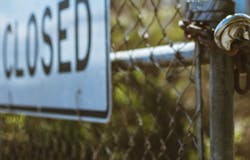As state and local governments across the country deal with the effects of COVID-19, contractors are dealing with the guidelines and regulations that can occur at a moment’s notice.
Getting prepared to take the necessary steps if a jobsite needs to be closed either by a government mandate or, worst-case scenario, due to someone having contracted COVID-19, requires documentation and a few key steps, as follows.
Consider Updating Your Contracts
In these difficult times, jobs can stop at a moment’s notice. Evaluate and consider updating your contracts to account for the responsibilities each party holds if a jobsite needs to be closed down.
If you already signed a contract with a customer, then set up a meeting to talk with them about what will happen if the jobsite needs to close.
And consult an attorney before making any changes to contracts.
Securing the Jobsite for a Shutdown
When a jobsite shutdown occurs, you need to make sure the site is secured and you must account for certain things to prevent your company from being held liable. You should:
- Talk to your insurance agent to ensure you're aligned on what’s covered in terms of theft and liability
- Barricade any dangerous terrain (trenches, open holes, etc.)
- Add warning signs
- Secure any tools and materials that need to be left behind to prevent theft
- Document and photograph the status of everything on the jobsite
- Consider installing surveillance systems and/or hiring security guards to monitor any suspicious activity (well worth it if you have expensive equipment on site)
Doing routine inspections after the site has closed to make sure everything continues to remain secure like you left it isn’t a bad idea either.
Adhere to Established Guidelines
Make sure all of your employees are following the latest safety guidelines established by OSHA and CDC when working and closing down a site to ensure you and your employees stay safe at all times.
Following the law is also crucial. If you’re given two days to close down the site, then you need to get the site closed in two days. Don’t try to circumvent the law. If you do, you risk devastating consequences in terms of financial costs and damage to your reputation.
Handle Each Jobsite Differently
While you should ideally have similar safety procedures for every jobsite, it’s important to keep in mind that every site differs with regard to how much work has been completed, how much work still needs to be done, and what stakeholders (subcontractors, vendors, customers) are affected.
You may also need to talk with the stakeholders affected to consider any contractual obligations that may arise. To maintain good relations, you should communicate with subcontractors, vendors, and customers to make sure they are informed about any updates regarding site closures or conditions.
Communicate With the Customer About Closing the Jobsite
It’s a good idea to do a walk-through of your plan with the customer to verify that everything is in proper order before closing the jobsite. You don’t want to end up having everything stored and your crew sent home only to receive an angry call from the customer complaining about how something wasn’t done or properly closed off.
Mark Soto is a roofing contractor at RoofingMKE, in Milwaukee. He is also a freelance writer.
RELATED
- Advice and Preliminary Policy From a Midsize Builder During the Pandemic: Al Trellis, president of Home Builders Network, suggests how builders can respond to the pandemic and provides one midsize builder's preliminary policy as an example
- A Great Impression—Jobsite Best Practice: Jobsite cleanliness is one of the most visible examples of your company’s standards and competence
- Can AI Predict Construction Hazards and Improve Safety? Five notable firms join a construction industry group that aims to use artificial intelligence to predict jobsite hazards

